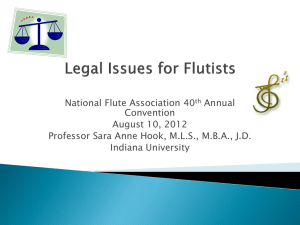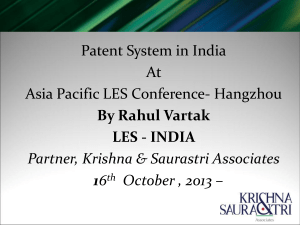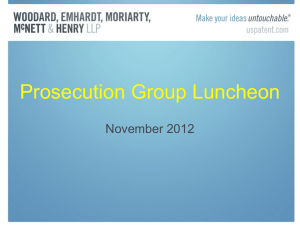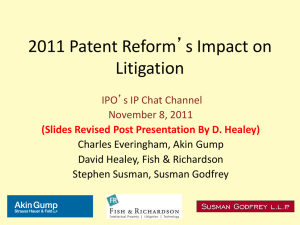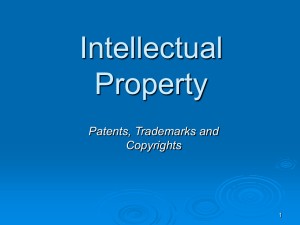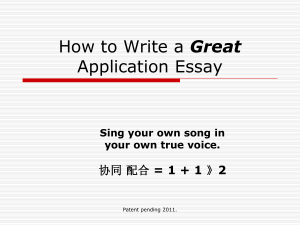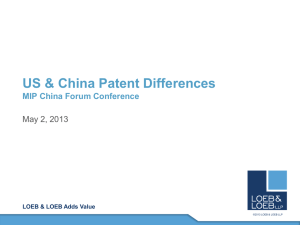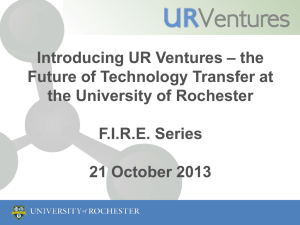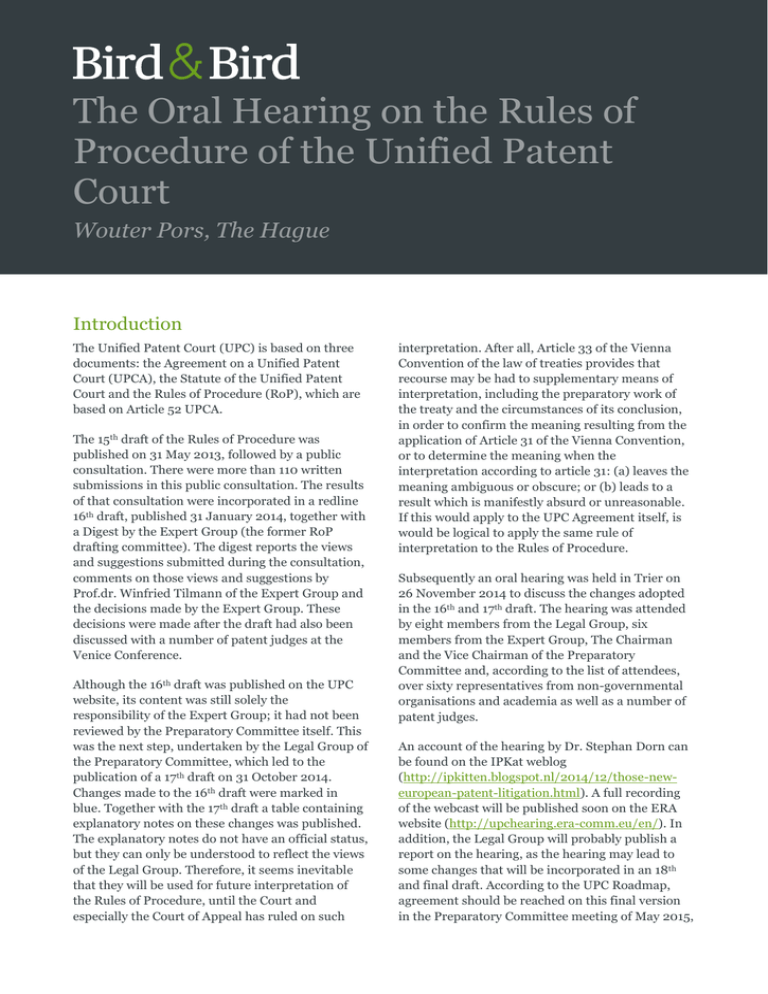
The Oral Hearing on the Rules of
Procedure of the Unified Patent
Court
Wouter Pors, The Hague
Introduction
The Unified Patent Court (UPC) is based on three
documents: the Agreement on a Unified Patent
Court (UPCA), the Statute of the Unified Patent
Court and the Rules of Procedure (RoP), which are
based on Article 52 UPCA.
The 15th draft of the Rules of Procedure was
published on 31 May 2013, followed by a public
consultation. There were more than 110 written
submissions in this public consultation. The results
of that consultation were incorporated in a redline
16th draft, published 31 January 2014, together with
a Digest by the Expert Group (the former RoP
drafting committee). The digest reports the views
and suggestions submitted during the consultation,
comments on those views and suggestions by
Prof.dr. Winfried Tilmann of the Expert Group and
the decisions made by the Expert Group. These
decisions were made after the draft had also been
discussed with a number of patent judges at the
Venice Conference.
Although the 16th draft was published on the UPC
website, its content was still solely the
responsibility of the Expert Group; it had not been
reviewed by the Preparatory Committee itself. This
was the next step, undertaken by the Legal Group of
the Preparatory Committee, which led to the
publication of a 17th draft on 31 October 2014.
Changes made to the 16th draft were marked in
blue. Together with the 17th draft a table containing
explanatory notes on these changes was published.
The explanatory notes do not have an official status,
but they can only be understood to reflect the views
of the Legal Group. Therefore, it seems inevitable
that they will be used for future interpretation of
the Rules of Procedure, until the Court and
especially the Court of Appeal has ruled on such
interpretation. After all, Article 33 of the Vienna
Convention of the law of treaties provides that
recourse may be had to supplementary means of
interpretation, including the preparatory work of
the treaty and the circumstances of its conclusion,
in order to confirm the meaning resulting from the
application of Article 31 of the Vienna Convention,
or to determine the meaning when the
interpretation according to article 31: (a) leaves the
meaning ambiguous or obscure; or (b) leads to a
result which is manifestly absurd or unreasonable.
If this would apply to the UPC Agreement itself, is
would be logical to apply the same rule of
interpretation to the Rules of Procedure.
Subsequently an oral hearing was held in Trier on
26 November 2014 to discuss the changes adopted
in the 16th and 17th draft. The hearing was attended
by eight members from the Legal Group, six
members from the Expert Group, The Chairman
and the Vice Chairman of the Preparatory
Committee and, according to the list of attendees,
over sixty representatives from non-governmental
organisations and academia as well as a number of
patent judges.
An account of the hearing by Dr. Stephan Dorn can
be found on the IPKat weblog
(http://ipkitten.blogspot.nl/2014/12/those-neweuropean-patent-litigation.html). A full recording
of the webcast will be published soon on the ERA
website (http://upchearing.era-comm.eu/en/). In
addition, the Legal Group will probably publish a
report on the hearing, as the hearing may lead to
some changes that will be incorporated in an 18th
and final draft. According to the UPC Roadmap,
agreement should be reached on this final version
in the Preparatory Committee meeting of May 2015,
after which the Rules of Procedure will be ready for
adoption by the Administrative Committee as soon
as the institutional provisions of the UPC
Agreement come into force, which is currently
planned to happen ahead of the opening of the
Unified Patent Court for litigation, on the basis of
Article 25 of the Vienna Convention of the law of
treaties.
There were of course some issues that were debated
lively at the oral hearing, but in general the
atmosphere was very positive. The general
approach was not criticism, but rather fine tuning
the final improvements.
Opt-out and opt-in
The first issue discussed was the opt-out regime.
Rule 5.13 now provides for a sunrise regime during
which the European Patent Office (EPO) collects
and processes the opt-out applications, which are
then transferred to the Court Registry on the day
the Agreement enters into force. Most participants
preferred the EPO to remain responsible for the
opt-out register, but the UPC Agreement clearly
states that it shall be kept by the Court Registry.
Unfortunately, Article 83 UPCA provides that an
opt-out shall take effect upon its entry into the
register, whereas a nullity action that blocks an optout will be pending as soon as it is filed online. The
Legal Group saw no room for an interpretation that
an application to opt-out shall have retroactive
effect to the date of its filing.
However, since Article 83 also allows opting out a
patent application whereas a nullity action can only
be started after grant, patent applicants who want
to opt out and who want to be on the safe side
should file their opt-out application in time for it to
be in the register on the date of grant of the patent.
The EPO is expected to allow updating the
proprietor data in its register after grant, which will
facilitate identifying who can file an opt-out
application.
New Rules 5.7 and 5.9 were called the “UPC forever
clause”. They serve to prevent contradictory
judgments as much as possible. Once an action is
pending or has been pending before the UPC, a
patent can never be opted out anymore. If a patent
is opted out, it cannot be opted in anymore once an
action is pending or has been pending before a
national court, even if that action was pending or
even concluded before the UPC Agreement entered
into force. So, if a patent is opted out after an action
is started before a national court, it can never be
opted in anymore. A decision to opt out thus
requires careful consideration.
The language regime
The next issue was Rule 14.2, which is aimed at
defending the interests of SME’s, but also of judges.
The discussion focused on Rule 14.2(c), which is
called the “English limited clause” in the
explanatory notes. It allows for litigation in an EPO
language, especially English, while at the same time
allowing for issuing the judgment in the national
language. The German judges were especially in
favour of this solution, supported by
representatives from German ngo’s and also by the
French judges.
The English limited rule is not a step towards
effective litigation, but rather a step back. In his
contribution to the IPKat weblog, Dr Dorn
misrepresents my intentions in commenting on it; I
was not representing any personal interests, but the
industry interest of LES International. Drafting a
judgment in a language that is different from the
language of the litigation and most likely different
form the language of the evidence will be
troublesome, for instance because the judges will
have to come up with translations of the technical
terms of the patent and the prior art without
assistance from the parties or the experts. Actually,
a translation into English will need to be made
anyway afterwards, for instance because English
will most likely be the international working
language within the UPC. In my view, the
advantage of being able to draft a judgment in one’s
native language does not outweigh the
disadvantages. Rather, UPC judges should be
willing to become sufficiently proficient in English
to be able to draft in that language.
However, it was made quite clear that Germany
would probably not allow litigation in English
without the English limited clause. The importance
of being able to enforce patents in the German local
divisions and present the case in English certainly
overrides the interest of having everything in one
language from the start.
Dr. Kühnen of the Düsseldorf Court stated that it
goes without saying that in such an international
cooperation one has consideration with the
interests of the others and he has a point in that.
Dr. Grabinski, judge at the German Federal Court
(Bundesgerichtshof) and member of the Expert
Group remarked that the claimant will normally
have the choice to bring his case before a division
that does everything in English, if he prefers that.
The current wording of Rule 14.2(c) provides what
parties may do, but does not limit what the court
may do. So, even in a member state that adopts the
English limited clause, a panel may still have the
freedom to draft the judgment in English too if
English is the main language of the proceedings.
That would thus allow for a flexible transitional
regime; judges who are not comfortable with
drafting in English may draft in their native
language, while others may draft in English, if that
is the language of the proceedings. Over time, the
second approach may become the preferred one.
Some attendees took Rule 14.2(c) one step further
and argued that it would allow the claimant to
submit its statements and plead in English, but at
the same time would allow the defendant to submit
its statements and plead in the national language,
since the provision says that the parties “may” use
the additional language. In their view this would
create a lot of flexibility at the hearing. This may
indeed also have been the intention of this rule, but
it creates a rather complicated situation which may
indeed make such a division rather unattractive to
claimants. In fact, it would mean that the claimant
would need to invest in translations of the
defendant’s submissions into English. On the other
hand, since most scientific literature is in English, it
is hard to imagine that a company will be active in
an innovative industry without being able to
communicate in English. For political reasons we
may need this provision, but it may add just
another element of forum shopping.
Rule 14.4 was criticized. If the registrar returns
pleadings because they are in the wrong language,
that may decide the case in favour of the other
party. That should at least require a decision by the
judge-rapporteur.
Injunctions
The discussion then turned to Rule 118, which is the
basic rule on injunctions. Section 2 has been
deleted from Rule 118, as it would have been
difficult if not impossible to meet the criteria of that
provision. Rather, the decision on granting an
injunction or other measures should be at the
discretion of the court. The explanatory notes
however state that, in view of Articles 63 and 25
UPCA, an injunction should normally be granted if
the patent was found valid and infringed. It was
argued at the hearing that this was also the starting
position of Advocate-General Wathelet in his
Opinion in Huawei vs ZTE, according to which an
injunction as such would not constitute abuse of a
dominant position.1 The Advocate-General also
held that, in view of the Enforcement Directive, in
view of competition law and in view of the freedom
to conduct business as protected by Article 16 of the
Charter of Fundamental Rights of the European
Union, bringing an action for an injunction could
only constitute an abuse of a dominant position in
exceptional circumstances, but this could be the
case if a standard essential patent was incorporated
in the standard technology following a FRAND
declaration to the standardisation body and if the
patent holder would subsequently behave unfair or
unreasonable when a licence was requested by a
third party.2 If bringing the action would be the
abuse, the consequence would probably be that the
action should be declared inadmissible, so claiming
an injunction might be risky in such a case.
The explanatory notes take the exception to
granting an injunction one step further by stating
that “only under very exceptional circumstances
(the Court) will use its discretion and not give such
an order”. Of course, the Legal Group could not
have foreseen which words the Advocate-General
would choose, but now it seems that this
requirement would go further than the requirement
of Huawei vs ZTE and such an approach might
therefore be an infringement on Union law, which
on the basis of Articles 20 and 24(1)(a) UPCA takes
priority over the UPC Agreement and the Rules of
Procedure. If the exact scope of Rule 118 would thus
be unclear, this might be an issue that needs to be
referred to the Court of Justice under Article 21
UPCA. It is therefore better to make it quite clear in
the explanatory note on Rule 118 that this rule
should be applied in conformity with Union law and
that the expression “only under very exceptional
circumstances” in the explanatory notes is no
intention to apply stricter criteria than prescribed
by Union law. In that respect, it may also not be
wise to merely state that there is no obligation to
implement Article 12 of the Enforcement Directive
since, although that may be true, a similar rule may
result from competition law and from Article 16 of
the Charter. Besides, as Prof. Tilmann pointed out,
it is also in Article 3 section 2 of the Enforcement
Directive, which is not an optional provision. Of
course, all of this will develop further when the
Case C-170/13, paragraph 61.
Paragraphs 59, 67 – 74 and the first answer to the
questions.
1
2
Court of Justice renders its judgment in Huawei vs
ZTE.
Fortunately, the panel said that the application of
Rule 118 would be at the discretion of the UPC
judges, quite a number of which have extensive
experience in this field. Actually, emphasizing that
the decision indeed is at the discretion of the panel,
without providing further guidance in an
explanatory note, is probably the safest approach in
view of Union law. Dr. Grabinski gave the example
of a patent on a very small feature of a mobile
phone – which would probably not be a standard
patent, but an implementation patent – that would
be found infringed. In such a case, an intermediate
solution might be to suspend the injunction for a
predetermined amount of time, to allow the
defendant to modify his product. One might add
that, obviously, the patent holder could then still
claim damages for the infringements that were
actually committed.
Leave to appeal
The last major issue tabled by the Legal Group was
leave to appeal. Final decisions of the Court of First
Instance, such as on validity and infringement, can
of course always be appealed, but the Court may
grant many types of orders in the course of
proceedings for which a leave to appel will be
required. Under Article 73 section 2(b)(ii) UPCA
this leave is granted by “the Court”, which created
doubts as to whether the leave should be granted by
the Court of First Instance or the Court of Appeal.
This has now been made clear. Case management
decisions and orders by the judge-rapporteur can
be brought before the panel for review under Rule
333. All orders by the panel as meant in Articles 49
section 5, 59 to 62 and 67 UPCA can be appealed
immediately without any requirement of leave. For
all other orders and decisions from the panel,
including those reviewing judge-rapporteur orders,
leave to appeal is required. This leave can be
granted by the Court of First Instance itself.
However, if it refuses to do so, a reasoned request
for leave to appeal can be filed with the Court of
Appeal under Rule 220. This will be dealt with by
the Court of Appeal’s standing judge for urgent
actions as meant in Rule 345.5 on a discretionary
basis, meaning that he may deny the request even
without giving reasons for the denial. If he does
grant leave, the matter is assigned to a panel of the
Court of Appeal for a decision.
The new rule is a considerable improvement, since
it prevents that first instance divisions try to uphold
undesirable approaches of important issues. It has
been drafted mainly as a tool that enables the Court
of Appeal to determine best practices where
needed. Prof Tilmann remarked that if the Court of
First Instance grants leave to appeal, this means
that it wants guidance on the issue, so in that case
there should always be a full appeal, resulting in a
reasoned decision. However, in order to keep the
intermediate procedural appeals manageable where
the Court of First Instance refused leave, the Court
of Appeal's standing judge should be able to deny
them without having to give reasons for such
denial. Of course, the issue can always be raised
again at the appeal against the final decision, but
that will not slow down the proceedings in first
instance.
Everyone saw this as a very welcome improvement
and most attendees agreed with the new system.
Nevertheless, it would of course be helpful if the
standing judge would give some reasons for his
decision in those cases where a denial of an
intermediate appeal would not be obvious.
Miscellaneous
Next some more minor issues were discussed,
though some of them may have quite an impact.
It became clear that there will be no written
transcripts of the court hearings, since they will be
audio recorded under Rule 115; video recordings
were deleted in the 17th draft.
Rule 105 provides that the interim conference
should preferably be held by telephone or video
conference, which is also emphasized in the
explanatory notes. However, it seems the thinking
on this has changed recently. Mr Véron of the
Expert Group said that a video connection is still
too vulnerable. An unwilling defendant could thus
easily slow down proceedings. Face-to-face
meetings would still be preferable, even though it
might sometimes mean that a party has to travel a
long distance. Indeed, there is scientific evidence
that people behave differently when facing their
opponents and judges instead of just looking at a
camera and a TV screen. So, if the aim of
proceedings includes establishing the truth, face-toface meetings are certainly preferred.
There was some discussion on when the Court of
Appeal should refer a case back to the Court of First
Instance. Here an issue is that civil law courts do
not always decide all issues that were presented to
them when they can decide the case on the basis of
just one issue. For instance, if a patent is found
invalid, a civil law court will normally not give a
reasoned decision on infringement, except that an
invalid patent cannot be infringed. If the Court of
Appeal then overturns such a decision, the parties
would be deprived of an instance if the case were
not referred back to the Court of First Instance.
Again, this is an issue where the Court of Appeal
will have to develop best practices since – as Mr.
Justice Birrs pointed out – nobody wants a system
that institutionalizes long expensive first instances,
but no-one wants a system of ping-pong courts
either.
Of course representation before the court was
discussed. The requirements both for lawyers and
for European Patent Attorneys were discussed. For
lawyers, Rule 286.1 now refers to Article 1 of
Directive 98/5/EC, which serves to facilitate
lawyers from one EU Member State to practice in
another EU Member State. However, this Directive
requires the lawyer to be a national of an EU
Member State, meaning that lawyers from outside
the EU do not qualify, not even if they have been
admitted to the bar in an EU Member State.
Lawyers from a non-UPC EU Member State can
qualify if they are registered as a lawyer in a UPC
Contracting Member State under Directive
98/5/EC.
Similarly, under Article 134 section 2(a) EPC, only a
national of an EPC Contracting State can become a
European Patent Attorney. However, they don’t
need to be a national of a UPC Contracting Member
State in order to be allowed to act as representative
before the UPC, nor do they need to register in such
a Contracting Member State. Of course, Article
48(2) UPCA requires a patent attorney to have
appropriate qualifications, especially a European
Patent Litigation Certificate, and the discussions on
the requirements for that are still ongoing.
Whatever the outcome may be, parties litigating
patents, especially in an international context, will
normally be quite capable of selecting appropriate
representation.
Rule 287 on attorney-client privilege, even though
it of course only applies to litigation before the UPC
and related advisory work, was welcomed as an
accomplishment that could set an example for
mutual recognition of privilege by WIPO member
states, a process that has been ongoing for many
years.
Issues from the floor
After the last coffee break the attendees could raise
their own issues. However, this time there was no
immediate response from the Legal Group and the
Expert Group; the issues raised were noted for later
consideration.
Unitary effect can only be requested within one
month after grant of the European patent.
Decisions on this can be appealed to the UPC under
Article 32(1)(i) UPCA and are governed by Rule 85
and further. If unitary effect is refused, the patent
still has to be validated in EPC Member States
within 3 months from grant. Basically this means
that a judgment on such a refusal needs to be
rendered at very short notice. This seems very hard
to achieve, but that can only be solved by extending
the term for validation in the national laws of the
countries that participate in the Unitary Patent. I
think these laws could for instance provide that, in
case a request for unitary effect is filed, validation
as a traditional European patent should be
requested within three months after the refusal to
grant unitary effect has become final.
Obviously, the issue of the so-called bifurcation gap
was raised. This gap could occur in case of
bifurcation, where the claim for revocation of the
patent is referred to the Central Division, whereas
the infringement action remains pending before a
Local or Regional Division, if infringement is
decided and the patent is found infringed before
validity is decided. This is a common problem – or
advantage, depending which side you are on – in
German patent litigation.
In UPC proceedings the risk of a bifurcation gap is
somewhat limited anyway, since under Rule 37.1
normally the decision on bifurcation will be taken
after closure of the written procedure. The duration
of the interim procedure is normally limited to
three months, according to Rule 101.3, after which
the oral hearing that concludes the proceedings
should follow within some two months, according
to Rule 108. However, under Rule 37.2 the panel
may decide on bifurcation at an earlier stage, in
which case the risk of a bifurcation gap becomes
larger. Rule 37.5 now provides that in case of
bifurcation the Local or Regional Division that
handles the infringement action shall communicate
the dates for the interim conference and the oral
hearing to the Central Division, if it does not
suspend the infringement action until validity has
been decided. In that case, Rule 40 further provides
that the Central Division will accelerate proceedings
and endeavour to set a date for the oral hearing
prior to the oral hearing on infringement. It was
argued at the oral hearing, especially by David
Laliberté of the Industry Coalition, that Rule 37
should in addition provide that enforcement of a
ruling on infringement should be suspended until
validity would be decided, or should at least be
made subject to a sufficient security. However, it
may not be so easy to follow up on the security. Dr.
Grabinski pointed out that the case law on liability
for damages due to enforcement of an injunction if
a patent was later found invalid varies throughout
the Contracting Member States, whereas the UPC
Agreement currently provides no legal basis to
recover such damages through UPC proceedings.
On behalf of LESI I questioned whether Rule 25.1(i)
and 25.2, which have as an effect that the patent
owner can be made a party to proceedings on a
counterclaim for revocation of a patent in
infringement proceedings brought by a licensee
through simple service of the counterclaim on the
patent owner by the Registry, would be in
conformity with Article 47(5) UPCA, according to
which the validity of a patent cannot be contested in
an action for infringement brought by the holder of
a licence where the patent proprietor does not take
part in the proceedings.
Rule 262 deals with confidentiality of court files. It
should include a rule that, if confidentiality is
requested, it will be maintained until there is a final
order on the issue.
Rule 271.7 deals with the right to a translation of
the Statement of Claim. However, since the UPC
will use an online filing system and therefore the
Statement of Claim may be printed and served by
the sub-registry in the home country of the
defendant, it may not be transmitted from one
Member State to another for service there within
the meaning of Article 1 of the Service Regulation
(EC) 1393/2007. This was covered in the 16th draft
by using the words “where the defendant would be
entitled to refuse service if Article 8 of the EU
Service Regulation were applicable”, but it is not
covered by the 17th draft, which incorrectly assumes
that Article 8 does apply, so this latest change
should be undone.
Conclusion
Obviously, it is impossible to report everything that
was said at the oral hearing. However, the Legal
Group did take notes on every contribution, so if
they produce a report, it will probably be quite
comprehensive. Besides, it will always be possible
to study the recording of the webcast.
The hearing actually closed 15 minutes early and in
a very positive spirit. It is safe to assume that the
changes proposed in the 16th and 17th draft will be
adopted by the Preparatory Committee, probably
with some further minor tweaks. This will create a
final version that will have broad support, which
will provide a good start for the Unified Patent
Court. It is actually quite an accomplishment to
create a new, autonomous procedural law that
incorporates both civil and common law in a
balanced system that will provide for very effective
litigation within a controlled time frame. This will
certainly be a very good tool box for patent
litigation for 25 EU countries in a single court.
Contact
Wouter Pors
Partner, Intellectual Property
The Hague
Tel: +31 (0)70 353 8825
Wouter.pors@twobirds.com
twobirds.com
Abu Dhabi & Beijing & Bratislava & Brussels & Budapest & Copenhagen & Dubai & Dusseldorf & Frankfurt & The Hague & Hamburg &
Helsinki & Hong Kong & London & Lyon & Madrid & Milan & Munich & Paris & Prague & Rome & Shanghai & Singapore & Skanderborg
& Stockholm & Sydney & Warsaw
Bird & Bird is an international legal practice comprising Bird & Bird LLP and its affiliated and associated businesses.
Bird & Bird LLP is a limited liability partnership, registered in England and Wales with registered number OC340318 and is authorised and regulated by the Solicitors Regulation
Authority. Its registered office and principal place of business is at 15 Fetter Lane, London EC4A 1JP. A list of members of Bird & Bird LLP and of any non-members who are
designated as partners, and of their respective professional qualifications, is open to inspection at that address.


